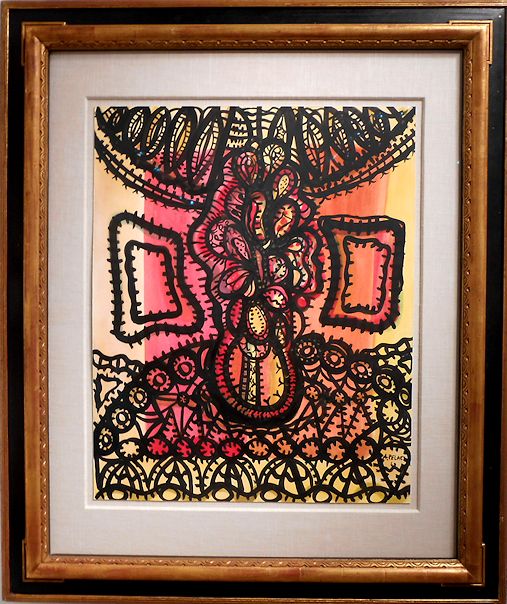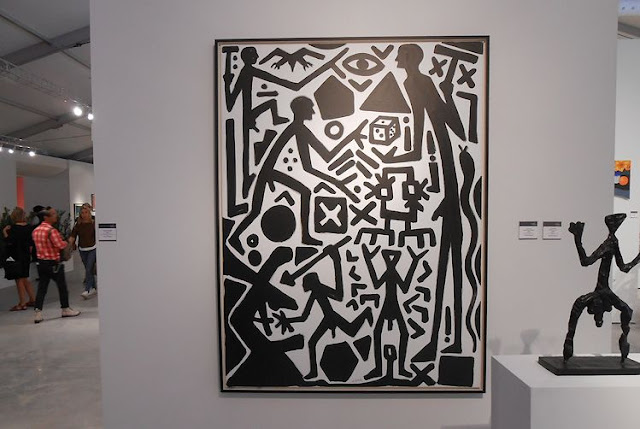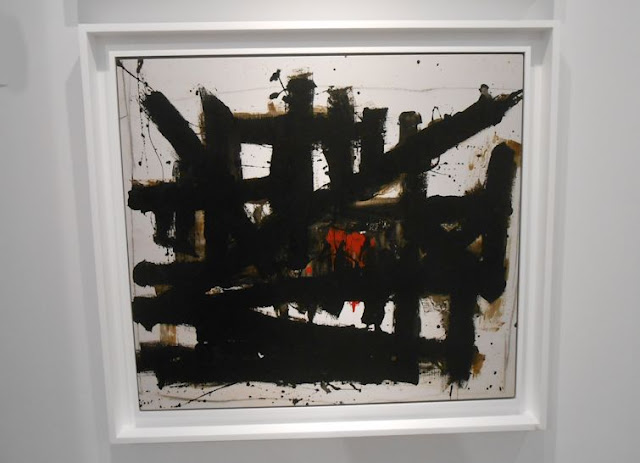Irina Gonzalez. "After the Rain." Cuba.
Gonzalez paints great detail into her paintings, especially of
women's clothes. They are fantasy or dream-like. These paintings
were in the Cernuda Arts Gallery, the best for Latin American art,
and especially Cuban. Their main gallery is in South Miami.
Irina Gonzalez. "Evening Breeze." Cuban
The elaborate dress and the cat are typical of Irina's works.
My favorite Cuban artist is Amelia Pelaez, who studied with a
stained glass artist, among other teachers. She uses strong black
outlines like the leading of a stained glass window. This work
is entitled "Vase on a Lace Tablecloth."
Amelia Pelaez. "Bouquet on Table." Cuban
Peter Anton. "Delicacies." This box is about five feet high and each piece of dandy
about eight inches long. They are made of various materials. He also makes donuts
and cupcakes and other sweets.
Mel Ramos. "Chiquita Bananas." U.S. Pop Art
Three examples of abstract art. On the left is a sculpture by the British artist, Barbara Hepworth;
in the enter is "Open in Ochre" by Robert Motherwell: and on the right is "Omega" by Larry Zox.
in the enter is "Open in Ochre" by Robert Motherwell: and on the right is "Omega" by Larry Zox.
Larry Zox. "Artine." U.S. Abstract / Hard Edge
John Chamberlain. "Ethel." U.S. Auto parts.
John Chamberlain developed a style of sculpture using hoods and fenders from autos,
which he retrieved from junk yards. He bent the pieces, shaped them, and painted them
into large sculptures meant for outdoors.
A. R. Penck is a very famous German artist who makes use of primitive-looking stick
figures to create scenes of ambiguity and often violence.
Anthony Caro is the Father of British Assemblage sculpture. He takes found pieces of
metal and welds them into a visual calligraphy. All young British sculptors follow him
in one way or another.
Michael West. "Vietnam." U.S. Abstract Expressionism
After WW II, New York replaced Paris as the Capital of Arts, and Abstract Expressionism,
with its powerful strokes, highly individualistic approach, and very large size seemed to
epitomize what America was, in contrast to the delicacy of Neo-Classicism or
Impressionism in Europe. In this case the artist is a woman, as many of these Ab-Exps
were. But no one knew it. When she signed her real name of "Corinne," critics and
collectors said the painting was too soft and feminine. But when Corinne's lover,
the artist Arshile Gorky, suggested she use a man's name, she did, and immediately
the unwitting critics and collectors praised the work as "strong, masculine, and
vigorous." Most people still do not know that "Michael West" was really "Corinne."
Michael Corinne West. "Untitled." U.S. Abstract Expressionism / Action painting. 1954
Cha Jong Rye. "Expand." Korea.
Cha is a woman, and she assembles many pieces of wood into a large sheet and then
sands it by hand to create this amazing panel which looks like a folded piece of paper.
Gino Miles. "Millenium." U.S.
Gino creates this work by assembling many pieces of steel, welding them together, and
then applying the mirror stainless surface. The piece is also perfectly balanced on a
small bolt and can easily be rotated. It appears to change forms continually as it
moves. I've met Gino, and he said it is OK to move the sculptures, so I did, to the
horror and shock of many people walking around. But it was fun.
Raymond Hendler. "Hero on the Rocks." 1967
Raymond Hendler. "Barbara's Way." 1969
Rafael Rangel. "Cups" on left. Rafael Barrios "Metamorfosis" in center.
The Barrios piece is actually a flat sheet of steel which has been cut and painted to
give the illusion of dropping back in space. For sure. I went and touched it and
got next to it and saw the back - it's perfectly flat. He is one of the leading artists
in the Op Art or Retinal Art Field, most famous in Venezuela.
in the Op Art or Retinal Art Field, most famous in Venezuela.
Rafael Barrios. "Four Red Rectangles." Venezuelan-American
This also is simply a flat piece of aluminum,which has been cut and painted
in an illusionistic fashion so that it looks like it is receding in space.
But it is perfectly flat and hangs on the wall. Op Art.
This also is simply a flat piece of aluminum,which has been cut and painted
in an illusionistic fashion so that it looks like it is receding in space.
But it is perfectly flat and hangs on the wall. Op Art.
Ilya Bolotowsky. "Four Works." Russian-American.
Ilya was born in Russia, but lived most of his life in New York City, where he was one
of the leading Abstract artists. This new style, which was first created and
developed in Russia and France, was brought to the U.S. by artists like Ilya.
Ilya was born in Russia, but lived most of his life in New York City, where he was one
of the leading Abstract artists. This new style, which was first created and
developed in Russia and France, was brought to the U.S. by artists like Ilya.
Carl Holty. "Untitled." 1955
Carl Holty was new to me, but it turns out he was a German-born American abstract painter,
who grew up and trained in Wisconsin - the first of Wisconsin's great artists (Georgia O'Keeffe
came later). He was one of the founders of the American Abstract Artists Group, which
was the first group of Americans to work in the new style. His works were forgotten
until recently, but are now being rediscovered and studied.
Carl Holty. "Three Works." 1950s
Gene Davis. "Pink and Green."
Davis didn't like all that slashing and dripping paint; he was interested in control and
rationality and obliterating his presence and strokes.
Adolph Gottlieb. "Long-Time." 1962
Gottlieb was strongly influenced by Oriental religions and beliefs in duality.
Here the perfection and calmness of the circles contrasts with the clashing and
conflict of the forms below.
Alberto Cavalieri. "Twisted Column." Venezuela. Stainless Steel.
Helen Frankenthaler. "Background to the Moon." 1981 7 feet high
Frankenthaler was a leading members of the "Second Generation Abstract
Expressionists." She belonged to "Lyrical Abstraction" or "Color Field Painting."
She painted BIG, no dainty little wall-pieces for her. And she developed a
new technique of "soak and stain," in which she tilted her canvas against a table.
She then poured diluted pigment onto the canvas, so that it flowed down and
what happened was spontaneous, but also controlled, as she guided the pigment
with an ivory spatula.
For several years, Frankenthaler was married to Robert Motherwell, whose works are above.
Motherwell was very much a "Gestural" Abstract Expressionist, with powerful black
strokes of paint. These are three works in a large series.
Robert Motherwell. "I.H. Series." No. 2 U.S.
Robert Motherwell. "Untitled - For Jules Verne." Abstract Expressionism.
Motherwell was extremely prolific and interested in the interplay of
art and music and literature and philosophy. He did a whole series of works
actually incorporating pieces of music of the great masters, and another
series honoring and sometimes incorporating actual pages from literary
figures, likes Jules Verne.
Robert Motherwell. "I.H. Basque Series. V." Abstract Expressionism
Jean Arp. "Winged Entity." Bronze
Jean/Hans Arp was Alsatian, so he sometimes used his French name and sometimes the
German form. Alsace is the territory along the Rhine with Germany on one side and France
on the other, and they have traded ownership over the past two hundred years. Arp was
one of the founders of abstract sculpture and working alongside the others in Paris
in the early 20th century. His works are organic, fluid, changing.
on the other, and they have traded ownership over the past two hundred years. Arp was
one of the founders of abstract sculpture and working alongside the others in Paris
in the early 20th century. His works are organic, fluid, changing.
This is the booth for James Barron Gallery, which specializes in abstract art.
In front are five tall sculptures by Beverly Pepper, an American artist.
Lucio Fontana. "Concetto Spazial/ Spatial Concept." Italy.
Lucio Fontana, an Italian artist, one day slipped while painting, and his knife sliced
through the canvas he was working on. He was amazed by the result. For many years he
had been learning all the tricks of art schools to make a painting look like it had the depth
of a room or the depth of a landscape, although it is all painted on a flat surface. Now, he
had actually produced depth and space. He loved it and continued working on this theme
for the rest of his life.
Brad Howe. "Ochre and Cream." Aluminum.
Brad's works are illustionistic; they seem to move in and out, opening and closing.
Yayoi Kusama. "Pumpkin." Japan
Yayoi Kusama is an 86 year old lady from Japan who paints, draws, and makes
ceramic pumpkins covered with dots. She also makes entire rooms covered with
dots and mirrors, that you can walk through. This drawing sold for $89,000.
Wolf Kahn. "Fall Forest." U.S.
Wolf Kahn paints mostly landscapes, which look slightly out of focus, but which have
wonderful colors and atmosphere.
Takesi Haguri. "Modern Divine General" and "Chivalry." Carved wood. Japan.
Japanese Pop Art.
Jesus Rafael Soto. "MHT 14." Venezuela Op Art.
Soto is one of the leaders of the Op Art Movement in Venezuela
and has a world wide reputation. The hanging wires "vibrate" against the painted
lines as viewers walk by.
"If It's Not Weird I'm Not Interested."
Matt Donovan. "Green Honeycomb." U.S.
_
_
_










































Thanks!
ReplyDelete